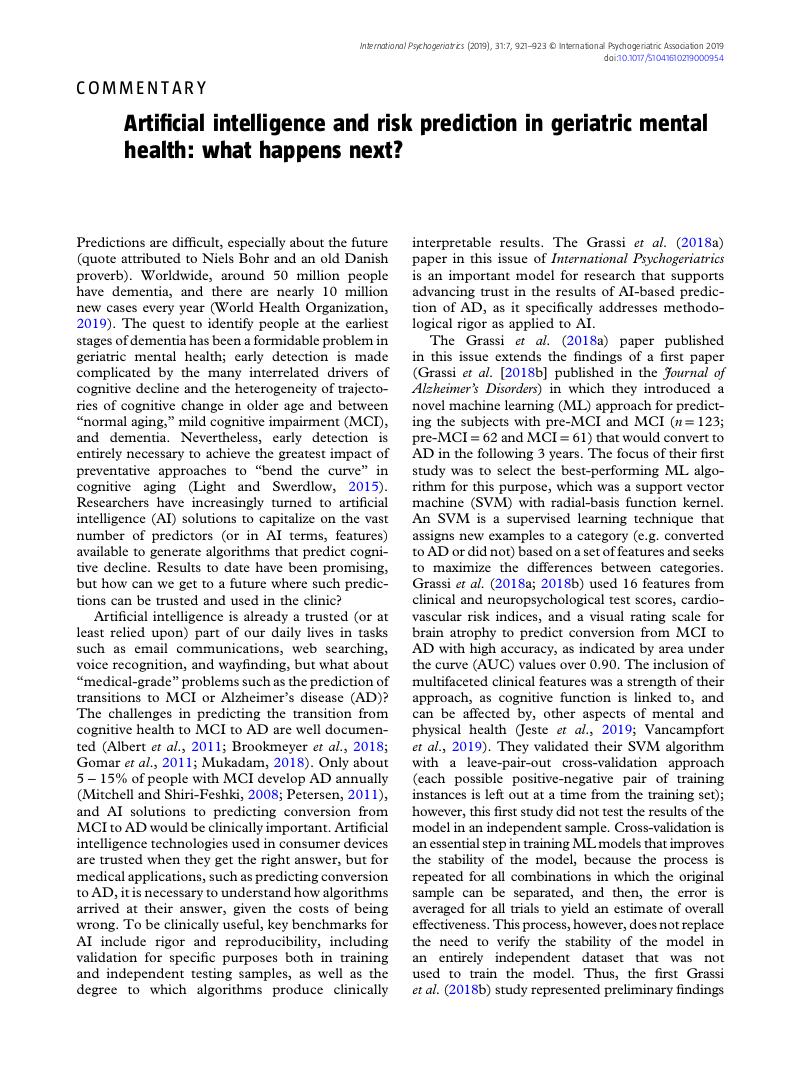Crossref Citations
This article has been cited by the following publications. This list is generated based on data provided by Crossref.
Treichler, Emily B.H.
and
Jeste, Dilip V.
2019.
Cognitive decline in older adults: applying multiple perspectives to develop novel prevention strategies.
International Psychogeriatrics,
Vol. 31,
Issue. 7,
p.
913.
Graham, Sarah A.
Lee, Ellen E.
Jeste, Dilip V.
Van Patten, Ryan
Twamley, Elizabeth W.
Nebeker, Camille
Yamada, Yasunori
Kim, Ho-Cheol
and
Depp, Colin A.
2020.
Artificial intelligence approaches to predicting and detecting cognitive decline in older adults: A conceptual review.
Psychiatry Research,
Vol. 284,
Issue. ,
p.
112732.
Pezoulas, Vasileios C.
Exarchos, Themis P.
and
Fotiadis, Dimitrios I.
2020.
Medical Data Sharing, Harmonization and Analytics.
p.
337.
Bernau, Leonard
Paulu, Filip
and
Voves, Jan
2020.
Proceedings of the 21st EANN (Engineering Applications of Neural Networks) 2020 Conference.
Vol. 2,
Issue. ,
p.
487.
Khan, Sahil
Barve, Kalyani H.
and
Kumar, Maushmi S.
2020.
Recent Advancements in Pathogenesis, Diagnostics and Treatment of Alzheimer’s Disease.
Current Neuropharmacology,
Vol. 18,
Issue. 11,
p.
1106.
Jeste, Dilip V.
Graham, Sarah A.
Nguyen, Tanya T.
Depp, Colin A.
Lee, Ellen E.
and
Kim, Ho-Cheol
2020.
Beyond artificial intelligence: exploring artificial wisdom.
International Psychogeriatrics,
Vol. 32,
Issue. 8,
p.
993.
Nagabhushan, P.
Sonbhadra, Sanjay Kumar
Punn, Narinder Singh
and
Agarwal, Sonali
2021.
Big Data Analytics.
Vol. 13147,
Issue. ,
p.
261.
Annaki, Ihababdelbasset
Rahmoune, Mohammed
Bourhaleb, Mohammed
Rahmoun, Noureddine
Zaoui, Mohamed
Castilla, Alexander
Berthoz, Alain
and
Cohen, Bernard
2022.
Digital Technologies and Applications.
Vol. 455,
Issue. ,
p.
190.
Sikström, Sverker
Kelmendi, Bleona
and
Persson, Ninni
2023.
Assessment of depression and anxiety in young and old with a question-based computational language approach.
npj Mental Health Research,
Vol. 2,
Issue. 1,
Bashir, Tabassum
Akhouri, Deoshree
and
Hamza
2024.
Intelligent Solutions for Cognitive Disorders.
p.
279.



